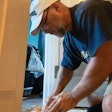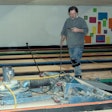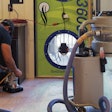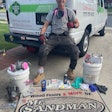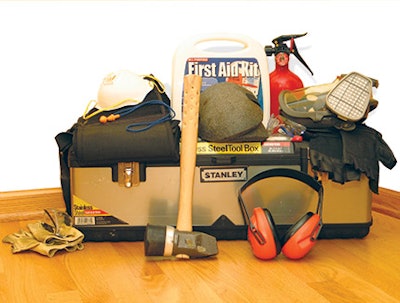
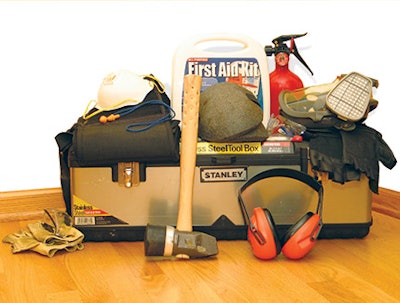
Get a group of seasoned wood flooring contractors in a room, and there's a good chance several will have tales of job-site safety mishaps, either from personal experience or from someone they know. Some contractors manage to escape with just minor injuries, but others suffer from serious lifelong disabilities. In some cases, an overlooked safety measure can prove to be fatal. While freak accidents do occur, most injuries can be prevented by taking simple safety precautions. Although some wood flooring contractors view their jobs as a risky profession, it doesn't have to be—if contractors make safety precautions a mandatory part of their jobs.
While reading warning labels can help prevent accidents from happening, nothing is more effective than hearing personal stories of contractors who didn't take the time to make safety a priority and are now paying the price. The following five contractors agreed to share their stories in hopes that they help prevent other wood flooring contractors from making the same mistakes.
 Bill Price, Floormasters International, Saugus, Mass.
Bill Price, Floormasters International, Saugus, Mass.
Bill Price - Floormasters International - Saugus, Mass.
I was diagnosed two years ago with a rare sinus cancer called adenocarcinoma. They found a golf-ball size tumor in my sinus cavity. Adenocarcinoma generally shows up as stomach or colon cancer. But in 0.1of 1 percent of cases, it shows up in the sinuses. And when it does, they know that it's directly related to wood dust and chemicals. This was determined by some studies done back in the 1980s in furniture factories in England where they had something like 400times the incidence compared with the general public of this type of cancer.
When they did my surgery back in 2003, they removed this tumor and said that it was gone and there was no sign of anything else. I was cancer-free. No chemotherapy, no radiation, nothing. When I went back to work, I made sure I wore a dust mask or respirator whenever I was exposed. Then, during a regular checkup a year later, the doctors found a small spot, did a biopsy and found that it was the same cancer but in a different area. They removed it, and there was no sign of anything left, but then they decided to do chemotherapy and radiation. They ordered 30 radiation treatments on my sinuses and six weeks of chemotherapy to go along with it at the same time. The side effects were rough.
In a lot of cases, people say, "That will never happen to me if it's that rare." I probably would've said the same thing. The big thing about it is that it takes upward of 40 years in some cases to show up. The doctor who did the original biopsy said it is from wood dust and chemicals. He referred me to the Dana-Farber Cancer Institute in Boston, and the doctor there said the same thing when they did the surgery and looked at the cells. Neither of the doctors could tell me if it was there for a long time, or if it was cumulative or from one exposure.
Anybody who is exposed to wood dust and chemicals doesn't know what could happen to them. When I started working back in the 1950s with my family, I was 12 years old, and I did all of the hand-sanding and sweeping, corner-scraping and that type of thing. So,I was exposed to all of this stuff from the time I was 12 years old. My brother,my father, all my uncles … nobody had this but me.
I think the most important thing is that people take precautions. There are no guarantees, and most floor finishers think they are invincible and will make excuses. After my surgery, I encouraged flooring contractors to go to their doctors and get checked if they had any kind of sinus problems. The way I found out was that I had sinus infections that wouldn't go away. I had monthly sinus infections, and the doctor kept putting me on antibiotics. Finally, he sent me to an otolaryngologist, who found a tumor. It wasn't something that was visible. I didn't feel it, because it was in my sinus cavities. So, I wouldn't have known had I not had the sinus infections. It's always worth checking if someone has a concern. It can happen to anybody in this industry. People don't want to mention cancer, but it's a reality.
This type of cancer is from wood dust and chemicals, and wearing respirators and dust masks is insurance. I see a lot guys take their respirators off when they're finished coating a floor and throw them in the back of the truck. They drive home, and their respirator is trying to clean the entire truck. The key to a respirator is to keep it clean and seal it in a plastic bag every time they are done using it and put it in the cab of their truck. Most respirators come in a plastic bag, and that's for storage. Most guy stake the plastic bag and throw it away. They don't change their filters anywhere near enough.
The message I have for people is to take care of yourself, because nobody else is going to do it for you. A lot of guy shave told me that because of what I have gone through, they now wear a respirator or dust mask all the time. That's a big plus. I think that guys can bury their heads in the sand as long as they want, but the reality is that this could happen to any one of them. It may not happen now—they're 25 years old and invincible—but by the time they are 50 or 60, they could have major problems. [Editor's Note: Bill Price Sr. passed away in 2015 after suffering from three types of cancer; his son, Bill Price Jr., noted after his passing how much his father would have wanted to encourage other wood flooring contractors to use personal protection equipment on the job site.]
 Charles Seabaugh, Seabaugh's Custom Hardwood Floors, Cape Girardeau, Mo.
Charles Seabaugh, Seabaugh's Custom Hardwood Floors, Cape Girardeau, Mo.
Charles Seabaugh - Seabaugh's Custom Hardwood Floors - Cape Girardeau, Mo.
At the age of nine, I began working with my father sanding and finishing hardwood floors. I worked with him throughout my school years, and the idea of needing ear protection was never even in our minds. I returned to the work in my early 30s and have continued to be exposed to the noises of the sanding and installation equipment on a regular basis. I am now65 years of age and have difficulty hearing normal conversation. I need to be directly facing the person speaking, and they need to speak in an above-average volume in order for me to understand what is being said. I miss much of what is being said in any group conversation with my family, friends or coworkers. In an auditorium setting, such as a church service, there are many words I cannot distinguish. Often, when everyone is laughing at something that has been said, I am turning to my wife to ask, "What did he say?" My youngest granddaughter has a very soft voice, and when she talks tome, I nearly always have to ask someone what she said.
I began to notice I was having difficulty hearing about 10 years ago. I found it easy to lay the blame on others for not speaking clearly, or not speaking loudly enough, rather than admitting that the problem was my hearing. When I began to notice my hearing loss, I should have—even then—begun using ear protection on a regular basis. I guess I was too set in my ways. Now I use it only occasionally, finding it easier to think,"It's too late for me." And, it is difficult to change old habits.
I see many contractors in all types of work who are not wearing ear protection. Fortunately, my sons have witnessed my hearing loss and are trying to develop the good practice of using ear protection. We really try to stress the importance of ear protection with all of our employees, also. It is so much easier to begin using ear protection early in your career rather than trying to change old, established habits. My advice to others is that—in whatever situation—now would be a good time to start protecting your hearing.
 Tom Macedo, Valley Hardwood Flooring, Fresno, Calif.
Tom Macedo, Valley Hardwood Flooring, Fresno, Calif.
Tom Macedo - Valley Hardwood Flooring - Fresno, Calif.
It was in 1978 when I was working with one of the many installers/refinishers in my business. The newest chop saw on the market at that time was the Rockwell with a 10-inch, 54-tooth carbide tipped blade. The many hours I spent that week cutting 5-inch-wide plank went smoothly with that new saw. My installer and I used it extensively. The tool worked so well that the thought of making a mistake with it seemed remote. People get that feeling when driving a great car that performs flawlessly, and yet when the mind loses concentration for a split second, a horrible wreck may occur.
I turned the saw on a back 45-degree angle and cut an upright piece of wood. I did not realize that the blade came through with an opposite angle. My finger was too close, and I never knew what happened till I saw the little digit 10 feet away on the floor.
I consider myself very lucky in that a missing left index finger is not a terrible handicap. The middle finger is very accommodating! But, for the first year or two, I was very concerned about people seeing my loss. That was mentally,not physically, handicapping. My feelings about my disfigurement were silly,but human, emotions.
Occasionally, the pain of hitting the stub end was maddening since the doctor didn't leave enough padding on the end of my bone. I almost went back and had more bone cut so more padding of tissue would grow over and protect it better. I gave up on that, and I rarely think of the loss until I type.
Any person operating any piece of equipment, from a saw to an automobile, should focus on total concentration. Focus on the tool in use, avoid distractions and have a discussion with your body parts before extending them. Actually look at your hands and say"hi," to them before sticking them in harms way. It only takes a second, yet it focuses you on safety. Evaluate your tool and safety guards like a pilot examines his plane before takeoff. Becoming complacent is the biggest danger. The tool is so easy to use that it becomes commonplace to forget its danger. It's like driving a car and not paying attention. You may almost always come to a complete stop at astop sign that you encounter every day. Just once you may roll through, and a car comes from the right, and bam! You have a crash.
RELATED: Power Up: How to Safely Power a Wood Flooring Job Site
 Greg Dunican, Midcoast Wood Floors, Damariscotta, Maine
Greg Dunican, Midcoast Wood Floors, Damariscotta, Maine
Greg Dunican - Midcoast Wood Floors - Damariscotta, Maine
Last October, I was on a typical sand/stain/finish job on a major remodel work site. Two of my crew members were edging in another area of the house while I was drum sanding in a large room. I had been drum sanding for at least two hours or more and was finally backing down the last interior wall. As always,you try to come as close to the wall while backing down in order to save on edging time and provide a better looking floor. Well, unbeknownst to me,there were two 110-volt wires that were buried by sheet rock mud inside of an outlet box. Both of the wire sets we re energized and were stripped back as if they were prepared for connection to an outlet.
The worst happened. My drum sander made full contact with both of these sets of wires, and the 220 volts shot through my drum sander and ran through my upper body through my left hand. Luckily, enough of the fuses in my sander shorted out and the circuits that were supplying power to the wires in the wall tripped. I was unsure of what just happened and found myself sitting on the floor up against the back wall 6 to 8 feet away! After I regained my wits and realized what happened, I shut the job site down for my crew and contacted the general contractor's foreman, alerting him to the situation. I then waited on-site for the electrician. All the while my condition was worsening—shortness of breath, irregular heartbeat, numbness and tingling.
Within 20 minutes, the electrical company showed up, and I showed them the wires and walked them through parts of the rest of the house with similar wires that I questioned as to whether or not they were "live." Indeed, after they tested other areas in the house, they found there were at least five groups of wires that were energized. As far as the wires that shocked me, their reply was that they did not know why they were energized,but that they were now capped off and taped securely.
Now I am plagued with depression,constant fatigue, memory loss and migraine headaches, all of which have taken its toll on my overall performance. With living comes bills—when you are not pulling down the numbers that your budget is accustomed to, there are bound to be bills that go unpaid. I suffered a 30 percent decrease in workload.
My advice is to be aware of your job site conditions. If you see one electrical condition that is questionable, then you should question the integrity of the entire electrical system. Look beyond the obvious. There are sometimes hundreds of electrical boxes that are installed prior to the sheet rock mud being applied. Well, as my luck happened that October morning, I was unfortunate and continue to pay today for a five-second mistake made by another contractor.
RELATED: Wood Floor Finish 101: The Low-Down on Today's Finishes
 Kevin Layman, A.R.K. Flooring Inc., Manalapan, N.J.
Kevin Layman, A.R.K. Flooring Inc., Manalapan, N.J.
Kevin Layman - A.R.K. Flooring Inc. - Manalapan, N.J.
Last July, one of my crews was out on a regular sanding job. After they finished for the day, they put the vacuum bags next to the garage. Usually we take our garbage out to the curb, but the homeowner wanted them left by the garage. Our rule is to always bring them to the curb, but my crew listened to the homeowner. Later that evening, I was going out to eat with my wife and another couple when I got a phone call. It was not a phone call you want to get.
It was a hot day, and for some reason a bag just ignited, and the flames got high. The side of the house went up inflames. All of the aluminum siding heated up and melted. The homeowner had nice brick fence on the walkway that got all charred up. The driveway was burnt from the heat. All of his garbage pails caught on fire. Thank God, the neighbors were home, and they put the fire out with their hoses before the firemen got there. If they weren't around, it could've been pretty bad, because that house would've burnt down. The fire caused $25,000worth of damage.
Actually, the homeowner was very nice about it, and thank God, I'm fully insured. My insurance company took care of everything, but we told the homeowner that whatever insurance didn't cover, we would take care of fully. It's just good business, and this is all I do for a living. You don't want your company to get a bad reputation.
I don't think a lot of guys realize what's really involved. It can happen,that's for sure. I know I'm not the only guy this has happened to, and we're really careful. I've heard similar stories where guys have lit the side of the house on fire. This happened to one of my guys that's been with me for 10years who knows everything. It was a fluke incident.
A lot of times what my guys do is,they'll use a lot of garbage bags during the day because you always have to keep the jobs clean when you're going to put a finish down. They may put the vacuum bags in the truck, and sometimes they forget. I've had instances where the bags have ignited in the middle of the night in the truck. It's something that has to be taken care of—it can be overlooked. Actually,about a month ago, I was driving with one of my guys in between jobs, and one my guys had put the vacuum bag in the back. The sun was beating down into the truck, and we pulled over because it started to smoke. It can be bad.
A lot of guys tend to put all of the garbage together. They'll take empty polyurethane cans with the saw dust and everything, and that could be like a bomb going off. You're dealing with flammable products. Sawdust itself is combustible. Sawdust can go off at any given time on its own. If it has any finish on it, it makes it even worse. It's even worse if someone used lacquer. You don't know what you're sanding off from someone else's mess.
What we do now is soak the vacuum bags in water and we wrap them separately in black plastic bags and put them on the curb. Every one of my trucks has a fire extinguisher. My guys really understand that now, because they realize that this can happen.
Massachusetts Fires Kill Three Flooring ContractorsIn July 2004, a floor sander died while sanding a floor in Hull, Mass. According to the Boston Globe, Captain Chris Russo of the Hull fire department said it was "a fireball that happened in a split second, charring everything in sight." The district attorney's office determined the fire was caused by a spark from the pilot light from the water heater and ruled the death an accident. It could not be determined if there were any safety violations, and because the victim was the sole owner of the company, charges were not filed. Then, just two months later, two Vietnamese flooring refinishers died after the house where they were working burst into flames. The two men were part of a crew of four who were refinishing a hardwood staircase in a home in Somerville, Mass. The two men who died were on the third floor of the home, while the two men working on the first floor received severe burns after they were chased out of the home by a raging fireball. Fire officials determined that a buildup of fumes in the house created from the fast-drying sealant and polyurethane detonated, leading to an explosive fire. The ignition source for the fire could not be pinpointed, but investigators found that all of the windows in the home were closed, the pilot light to the stove was turned on and the electricity had not been disconnected. At press time, the Labor Department was still pursuing a case against the owner of the floor company, but both sides were working on a settlement that included a mandatory safety education program. State Fire Marshal Stephen D. Coan described the Somerville fire as "an opportunity to take a look at whether there needs to be regulations in place." Two legislative measures have been introduced in the Massachusetts Legislature, but neither has been acted upon. One bill would require licensing of flooring companies and mandatory worker training, and the other bill would require flooring companies that use combustible materials to get a permit from the state's fire safety agency. "It would appear to me that these workers don't understand the volatility of the products they use and are not eliminating the potential ignition sources," Coan told Raja Mishra of the Boston Globe. "Something needs to be done." —C.L. |
Fire First Aid
Having a fire extinguisher on the job site could be the difference between a fire that burns the house down and one that is contained quickly. "Fire extinguishers are the first aid of fire equipment, which means they are meant to be used within the first two minutes of ignition," says Patrick O'Connor, a sales associate with Illinois Fire Extinguisher Co. Inc. in Addison, Ill. For every fire, contractors should call 911 to ensure the fire has been completely extinguished. O'Connor recommends flooring contractors have a 10-pound, multipurpose ABC industrial fire extinguisher with a steel cylinder with an aluminum or brass valve. A multipurpose extinguisher will cover the different classes of combustibles that can be found on a job site. For example, bare wood is a Class A combustible, and water would be sufficient to put out the fire. But, whenever the wood is treated with a chemical, it's considered to be Class B, and dry chemicals are recommended to extinguish the fire. With proper maintenance, a heavy-duty fire extinguisher will last a lifetime. Before you invest in an extinguisher, however, O'Connor recommends contacting your local fire department for clarification on requirements in your municipality. |




















